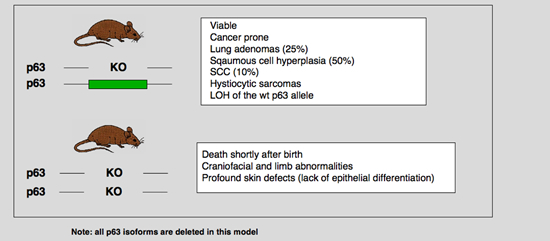| |
p53 Information
p53 information
p53 story
p53 monoclonal antibodies
p53 pathways
p53 gene
mdm family
mouse models
|
p63 KO mouse
Go back to the list
 |
Mills, A. A., B. H. Zheng, X. J. Wang, H. Vogel, D. R. Roop, and A. Bradley (1999) Nature 398:708-713.
p63 is a p53 homologue required for limb and epidermal morphogenesis
The p53 tumour suppressor is a transcription factor that regulates the progression of the cell through its cycle and cell death (apoptosis) in response to environmental stimuli such as DNA damage and hypoxia(1,2). Even though p53 modulates these critical cellular processes, mice that lack p53 are developmentally normal(3), suggesting that p53-related proteins might compensate for the functions of p53 during embryogenesis. Two p53 homologues, p63 and p73, are known(4,5) and here we describe the function of p63 in vivo. Mice lacking p63 are born alive but have striking developmental defects. Their limbs are absent or truncated, defects that are caused by a failure of the apical ectodermal ridge to differentiate. The skin of p63- deficient mice does not progress past an early developmental stage: it lacks stratification and does not express differentiation markers. Structures dependent upon epidermal-mesenchymal interactions during embryonic development, such as hair follicles, teeth and mammary glands, are absent in p63-deficient mice. Thus, in contrast to p53, p63 is essential for several aspects of ectodermal differentiation during embryogenesis. |
Yang, A., R. Schweitzer, D. Q. Sun, M. Kaghad, N. Walker, R. T. Bronson, C. Tabin, A. Sharpe, D. Caput, C. Crum, and F. McKeon (1999) Nature 398:714-718.
p63 is essential for regenerative proliferation in limb, craniofacial and epithelial development
The p63 gene, a homologue of the tumour-suppressor p53 (refs 1-5), is highly expressed in the basal or progenitor layers of many epithelial tissues(1). Here we report that mice homozygous for a disrupted p63 gene have major defects in their limb, craniofacial and epithelial development. P63 is expressed in the ectodermal surfaces of the limb buds, branchial arches and epidermal appendages, which are all sites of reciprocal signalling that direct morphogenetic patterning of the underlying mesoderm. The limb truncations are due to a failure to maintain the apical ectodermal ridge, a stratified epithelium, essential for Limb development The embryonic epidermis of p63(-/-) mice undergoes an unusual process of non-regenerative differentiation, culminating in a striking absence of all squamous epithelia and their derivatives, including mammary, lacrymal and salivary glands. Taken together, our results indicate that p63 is critical for maintaining the progenitor-cell populations that are necessary to sustain epithelial development and morphogenesis. |
Flores, E. R., S. Sengupta, J. B. Miller, J. J. Newman, R. Bronson, D. Crowley, A. Yang, F. McKeon, and T. Jacks (2005) Cancer Cell 7:363-373.
Tumor predisposition in mice mutant for p63 and p73: Evidence for broader tumor suppressor functions for the p53 family
p63 and p73 are functionally and structurally related to the tumor suppressor p53. However, their own role in tumor suppression is unclear. Given the p53-like properties of p63 and p73, we tested whether they are involved in tumor suppression by aging mice heterozygous for mutations in all p53 family genes and scored for spontaneous tumors. We show here that p63(+/-);p73(+/-) mice develop spontaneous tumors. Loss of p63 and p73 can also cooperate with loss of p53 in tumor development. Mice heterozygous for mutations in both p53 and p63 or p53 and p73 displayed higher tumor burden and metastasis compared to p53(+/-) mice. These findings provide evidence for a broader role for the p53 family than has been previously reported. |
More recent data with another p63 KO strain suggest that p63 +/- are not cancer prone
Keyes, W. M., H. Vogel, M. I. Koster, X. Guo, Y. Qi, K. M. Petherbridge, D. R. Roop, A. Bradley, and A. A. Mills (2006) Proc Natl Acad Sci U S A 103:8435-8440.
p63 heterozygous mutant mice are not prone to spontaneous or chemically induced tumors.
Homology between p63 and p53 has suggested that these proteins might function similarly. However, the majority of data from human tumors have not supported a similar role for p63 in tumor suppression. To investigate this issue, we studied spontaneous tumorigenesis in p63+/- mice in both WT and p53-compromised backgrounds. We found that p63+/- mice were not tumor prone and mice heterozygous for both p63 and p53 had fewer tumors than p53+/- mice. The rare tumors that developed in mice with compromised p63 were also distinct from those of p53+/- mice. Furthermore, p63+/- mice were not prone to chemically induced tumorigenesis, and p63 expression was maintained in carcinomas. These findings demonstrate that, in agreement with data from human tumors, p63 plays a markedly different biological role in cancer than p53. |
Go back to the list
|
|






